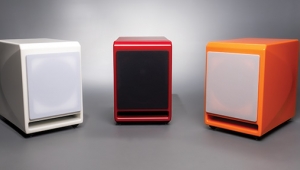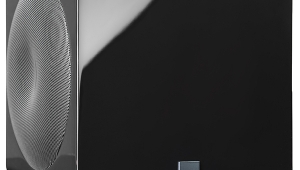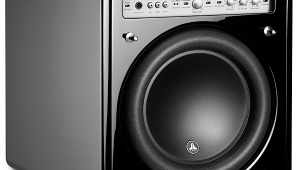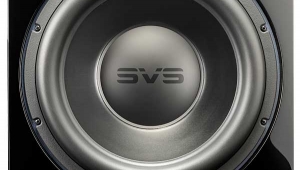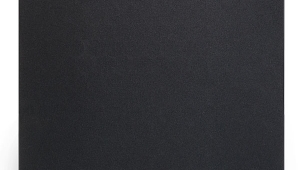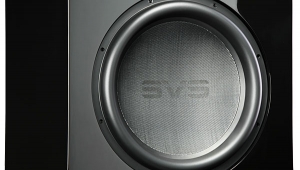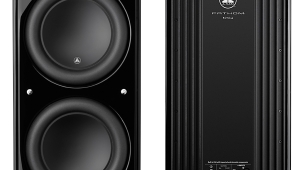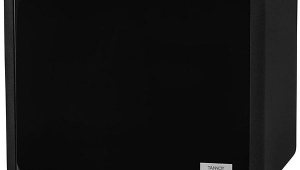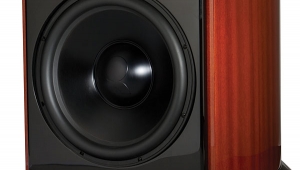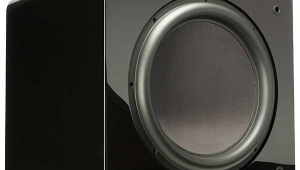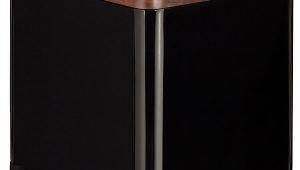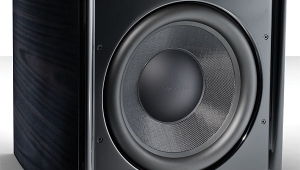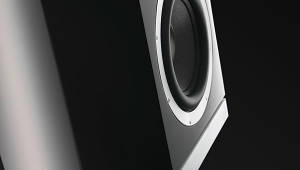| Columns Retired Columns & Blogs |
REL Acoustics Studio II powered subwoofer
From The Audio Catechism:
Q: What is a subwoofer?
A: A large, ugly device that must be placed in the most inconvenient location in the listening room—for instance, in front of the only door.
Q: What is the purpose of the subwoofer?
A: To produce prodigious amounts of low-frequency sound and to glorify its owner, who can rest safe in the knowledge that his is the biggest.
Q: What is a subwoofer?
A: A large, ugly device that must be placed in the most inconvenient location in the listening room—for instance, in front of the only door.
Q: What is the purpose of the subwoofer?
A: To produce prodigious amounts of low-frequency sound and to glorify its owner, who can rest safe in the knowledge that his is the biggest.
 Ah, but it doesn't have to be that way. At the same time that home theater has made "subwoofer" a household word, many high-end companies have also discovered that a deep, tuneful bottom end can serve as the solid foundation for the cathedral of music.
Ah, but it doesn't have to be that way. At the same time that home theater has made "subwoofer" a household word, many high-end companies have also discovered that a deep, tuneful bottom end can serve as the solid foundation for the cathedral of music.
REL is such a company. Their $8000 Studio II is a no-holds-barred unit that they call a "sub-bass system." Far from billing it as an add-on for speakers that lack bass extension, REL boldly states that any system will derive increased impact and solidity from the addition of a Studio II—even denizens of Stereophile's "Class A—Full Range Loudspeakers" category in "Recommended Components."
The real is only the bass...
The Studio II is reasonably handsome ("for a subwoofer," my wife sniffs). It's fairly sizeable at 231/4" by 213/4" by 141/2", but its black ash side panels, dark glass top, and stubby cylindrical brass legs make it look as much like furniture as a subwoofer's going to get.
The Studio II is designed to be placed against a wall, and the side of the woofer that goes against the wall is all business. Inputs and controls are arrayed across the utility panel: a phase-reversal switch; three control knobs (Coarse, Fine, and Gain); two RCA line-level inputs; two "professional-type" twist-lock connectors (High Level, which accepts speaker level, and High Level Balanced); a line-level three-pin XLR (600 ohms); a power switch; and an IEC mains receptacle. This arrangement gives the Studio II an unusually broad range of connection options and control.
The Studio II employs two heavy-duty 10" drivers in what REL refers to as an "Acoustic Resistive Matrix" (ARM) loading scheme. The manufacturer claims that ARM offers lower distortion and improved transient performance. The driver's back wave is loaded by a cavity that is vented "in a controlled way" (according to REL) into a smaller cavity, which then vents again into an even smaller one and, eventually, exits out the port. Even this explanation is somewhat simplified—there is yet another cavity, this one "for special control purposes."
Although ARM loading is complex—not to mention difficult to construct—REL feels it offers superior performance to conventional reflex loading, since the driver is said to "see" a smaller enclosure at higher bass frequencies. REL likens this to the advantage offered by a five-speed gearbox over a three-speed.
The 300W internal amplifier is DC-coupled, using triple-paralleled MOSFET output devices. The line-level and filter stages are fully regulated to ensure isolation from the power amp. The crossover filter stages are Sallen and Key two-pole (12dB/octave) types, and the filter capacitors are 1% tolerance, nitrogen-filled polystyrene types. Quite a contrast from the cheap'n'cheerful op-amp board stuck in many subwoofers as an afterthought!
Sumiko recommends that the subwoofer be connected to the main speakers' amplifier by way of its speaker-level inputs—this leaves your main speakers running full-range. It is fair to point out that using the REL does not therefore offer one of the main advantages of adding a subwoofer to a system: relieving the satellites of the stress of being asked to reproduce deep bass information. In addition, having three acoustic sources reproducing low bass in the room might make setup more problematic than usual. Why use this strategy, therefore?
Sumiko's John Hunter explained: "When you derive the signal from the amplifier that drives the speakers, you tend to preserve the sonic signature of that amp—so the sound from the Studio II will better match that of the main speakers." As I switched amplifiers in and out of the system, the sound did change, reflecting their differing characters. This was a subtle effect, certainly not day-and-night, but it went a long way toward making the system coherent. When you consider the Studio II's staggering price tag, it will probably be used in fairly sophisticated systems—the sort where tiny nuances become more pronounced.
You can also drive the REL with a line-level signal, which I tried just to see how it worked. As you'd expect, it worked fine, but I decided to stick with the importer's recommendations, seeing as how Sumiko has set up a lot more of these than I have. I had no complaints using the speaker-level umbilical.
But it is the bass
Setting the REL up—actually, properly setting up any topnotch subwoofer—is fairly complicated. Everybody "knows" that deep bass is nondirectional, but that doesn't mean you can just set a woofer up anywhere in a room and get it to integrate with your primary speakers and produce deep, nonspecific bass. How come? Well, it's the room, not the woofer, that causes all the problems. All rooms have antinodes that can cause bass to boom, and nodes or nulls that can sap the bass energy completely. This means that you must find the right place for the woofer, then you must carefully experiment with phase, gain, and the high-pass filter. This can take weeks of experimentation and listening. And the better the system, the more precisely the subwoofer must be dialed in.
Sumiko has devised a method for setting up REL woofers that is rather different from the instructions given in the owner's manual. The manual says to stick the woofer between the primary speakers and start the tuning-in process from there. This makes for a visually balanced system, but I've never lived in a room where such symmetry resulted in coherent top-to-bottom response.
Sumiko finds that corner placement works in the greatest number of systems. Pressurizing the room from the corner at frequencies below 50Hz provides more linear and uniform low-frequency response, they claim. It's possible to find good locations other than the corner, but nodal response problems tend to make this more complicated. (See Sidebar, "REL Setup Made Simple.") Just my luck, I couldn't use corner placement in my room, so I had to experiment extensively before settling in to a location that was adequate, if not ideal—in my room, this was along the right sidewall, about 3?' from the kiva-style fireplace that made a corner location impossible. In extremely difficult situations, Sumiko suggests that two smaller subwoofers may work better than a single larger one.
- Log in or register to post comments
